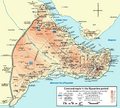Constantine XI facts for kids
Constantine XI Palaiologos (born February 8, 1405 – died May 29, 1453) was the very last Byzantine Emperor. He ruled from January 6, 1449, until his death. Constantine was the son of Emperor Manuel II Palaiologos and Empress Helena Dragas. He is famous for bravely defending his capital city, Constantinople, against the Ottoman Empire in 1453.
Contents
Early Life and Family
Constantine was born in Constantinople, the capital of the Byzantine Empire. He was one of ten children of Emperor Manuel II and Empress Helena. His family, the Palaiologos dynasty, had ruled the Byzantine Empire for a long time.
Growing Up in a Changing World
Constantine grew up during a difficult time for the Byzantine Empire. The empire, once very powerful, had shrunk greatly. It was surrounded by the growing Ottoman Empire. This meant he learned about war and diplomacy from a young age.
Ruling the Morea
Before becoming emperor, Constantine was a ruler in a part of Greece called the Morea (now the Peloponnese). He was known as the Despot of the Morea. He worked hard to make this area stronger and even tried to expand its borders. He rebuilt castles and tried to unite the local rulers.
Becoming Emperor
Constantine's older brother, John VIII Palaiologos, was the emperor before him. When John VIII died in 1448, Constantine was chosen to be the next emperor. He was crowned in Mystras, not in Constantinople, because the empire was facing many challenges.
Challenges as Emperor
As emperor, Constantine faced huge problems. The Byzantine Empire was very small and weak. The powerful Ottoman Empire, led by Sultan Mehmed II, was a constant threat. Mehmed II was determined to conquer Constantinople.
Seeking Help from Europe
Constantine knew he couldn't fight the Ottomans alone. He tried to get help from Christian countries in Western Europe. He hoped they would send soldiers and ships to defend Constantinople. However, many European leaders were busy with their own problems and didn't send much help.
The Fall of Constantinople (1453)
The biggest challenge Constantine faced was the Siege of Constantinople in 1453. Sultan Mehmed II brought a massive army and huge cannons to attack the city. Constantinople had strong walls, but the Byzantine army was much smaller.
Preparing for the Siege
Constantine worked tirelessly to prepare the city for the attack. He organized the defenses, repaired the walls, and gathered all available soldiers. He even welcomed foreign volunteers who came to help.
The Final Battle
The siege lasted for many weeks. The Ottoman army attacked the city walls day and night. Constantine fought bravely alongside his soldiers, inspiring them with his courage. On May 29, 1453, the Ottomans finally broke through the city's defenses.
Constantine's Last Stand
Constantine XI is remembered for his heroic actions during the final moments of the siege. He refused to abandon his city and his people. He reportedly charged into the fighting, leading his remaining soldiers, and died in battle. His body was never found, which added to his legendary status.
Legacy
Constantine XI is seen as a hero in Greek history. He is remembered as the brave emperor who stood up against overwhelming odds to defend his city. His death marked the end of the Byzantine Empire, which had lasted for over 1,000 years.
A Symbol of Courage
Even today, Constantine XI is a symbol of courage and sacrifice. His story reminds people of the importance of fighting for what you believe in, even when facing impossible challenges.
Images for kids
-
Miniature from an early 15th-century manuscript depicting Constantine's father Emperor Manuel II Palaiologos, his mother Helena Dragaš and his three older brothers John, Theodore and Andronikos
-
1422 map of Constantinople by catographer Cristoforo Buondelmonti, the oldest surviving map of the city
-
Ruins of the castle at Patras, captured by Constantine in 1430
-
Map of Byzantine Constantinople
-
Contemporary sketches by Pisanello of the Byzantine delegation at the Council of Florence. The figure mounted on the horse is Constantine's brother, Emperor John VIII Palaiologos.
-
The Despot's Palace in Mystras, from which Constantine ruled as Despot of the Morea 1443–1449
-
The Crusade of Varna, sent to aid the Byzantines against the Ottomans, was crushed by Sultan Murad II at the Battle of Varna (pictured) in 1444
-
1/8 stavraton, minted 1448–1453. One of the last coins minted by the Byzantine Empire, the coin features a bust of Constantine XI (left) and Christ Pantocrator (right).
-
Portrait of Sultan Mehmed II by Gentile Bellini (1480)
-
Cardinal Isidore of Kiev, sent as a papal legate to Constantinople in October 1452
-
Modern painting of Mehmed II and his army approaching Constantinople, by Fausto Zonaro (1903)
-
Modern painting of the Ottoman fleet being transported over land to the Golden Horn, by Fausto Zonaro (1903)
-
The Last Siege, French miniature by Jean Le Tavernier painted sometime after 1455
-
Romanticized depiction of the final fighting at the Fall of Constantinople by Greek folk painter Theophilos Hatzimihail (1932). Constantine is depicted as charging into battle on a white horse.
-
An icon of Constantine XI
-
19th-century depiction of Constantine XI with classical Greco-Roman armor
-
Constantine XI as depicted in 1584 by André Thevet
See also
 In Spanish: Constantino XI Paleólogo para niños
In Spanish: Constantino XI Paleólogo para niños

























